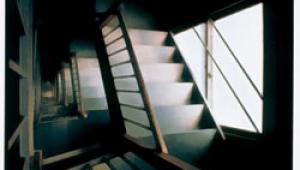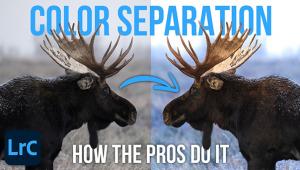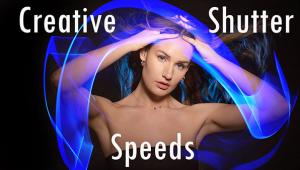Choosing and Using Lenses A Glossary of Lens Terms
Aperture: The aperture is the opening in the lens that lets light in. The aperture ring controls the size of this opening, and thus the amount of light transmitted to the film. Apertures are indicated in f-numbers: f/4, f/11, etc. The f-number is the ratio between the diameter of the aperture and the focal length of the lens: f/4 means the aperture diameter is 1/4 the focal length of the lens (25mm on a 100mm lens); f/11 means the aperture diameter is 1/11 the focal length of the lens (9mm on a 100mm lens). This is why larger f-numbers represent smaller aperture diameters, and vice versa.
APO: Uncorrected lenses tend to focus short (blue) wavelengths in front of medium (green) ones, and long (red) wavelengths behind medium ones. APO (short for apochromatic) lenses bring all wavelengths of the visible spectrum into focus at the same place—the film plane; i.e., they correct for chromatic aberrations, usually by means of multiple elements made of different-dispersion materials. Apochromatic correction is especially important in long focal-length lenses.
Aspherical Elements: With conventional spherical lens elements, light rays entering at the edge of the lens are bent more than light rays entering at the center, and thus focused closer to the lens. Aspherical elements have nonspherical shapes designed to bring all the light rays in focus at the film plane for sharper images. Aspherical elements are especially important in wide-angle lenses, where they also help to reduce distortion. Aspherical elements also help to produce smaller, lighter and less-costly zoom lenses.
Depth of Field: Depth of field refers to the area in front of and beyond the point focused on in which objects appear sharp in the photograph. Depth of field is controlled by the lens aperture setting (smaller apertures increase depth of field, large apertures decrease it), as well as by the shooting distance (greater distanced increase depth of field) and lens focal length (depth of field is greater with shorter focal lengths). But depth of field is really an illusion. Only the point focused on is truly sharp. As a subject moves closer to or farther from the camera, its image becomes less sharp. Within depth-of-field limits, objects will appear acceptably sharp in moderate-sized prints, but objects at the distance focused upon will be sharpest. Another consideration: Lenses tend to produce the sharpest results at their middle apertures. At large apertures, various aberrations reduce sharpness, and at small apertures, diffraction reduces sharpness. So for sharpest results, shoot at medium apertures unless the light level requires a large one, or you need lots of depth of field. Note: Depth of field should not be confused with depth of focus, which is the minute amount the film plane can be moved toward or away from the lens before sharpness is affected.
Distortion: Distortion comes in two basic forms. In pincushion distortion, straight lines near the edges of the frame bow inward toward the center of the image. With barrel distortion, straight lines near the edges bow outward away from the center. Such distortions are often evident in zoom lenses, with barrel distortion appearing at the short focal lengths and pincushion distortion at long focal lengths.
ED, LD, SD, SLD or UD Elements: These are abbreviations for Extra-low Dispersion (Nikon and Pentax), Low Dispersion (Tamron), Super Low Dispersion (Tokina), Special Low Dispersion (Sigma) and Ultra-low Dispersion (Canon). All of these terms mean that the lens contains at least some elements of low-dispersion glass or other material, which minimizes a type of chromatic aberration that plagues long focal-length lenses. LD elements result in lenses that are sharper, with greater color accuracy and less flare.
Elements/Groups: Photographic lenses consist of a number of optical elements, arranged in one or more groups. Each element refracts (bends) light differently, due to its shape and composition. When optical engineers design a lens, they use different-shaped elements of various compositions in various combinations to make the light do what they want it to do. Computers help them answer the "What if?" questions: "What if we replace this element or group with this one?" But it's still people who design the lens. Zoom lenses generally contain the most elements, because they must correct for aberrations at a variety of focal lengths.
Filter Size: This is the diameter of the threads on the front of the lens—72mm means 72mm-diameter filters and accessories will screw right onto these threads. You can attach larger or smaller filters by using step-up or step-down rings, but it's not a good idea to use smaller filters—vignetting will likely occur.
Focal Length: The focal length of a lens is the distance from the lens's "optical center" to the film plane, when the lens is focused at infinity. With a telephoto lens, the "optical center" is actually in front of the lens—a telephoto lens is physically shorter than its focal length. The focal length determines the magnification of the image, as well as the angle of view. Greater focal lengths produce greater magnification at a given shooting distance (but longer lenses tend to have greater minimum focusing distances), along with a smaller angle of view.
Focus: One primary function of a photographic lens is to sharply focus the subject's image on the film. When a lens is focused on a subject at a certain distance, images of more-distant subjects will be focused in front of the film plane, and images of nearer subjects will be focused behind the film plane. The farther from the focused distance a subject is, the more blurred ("out of focus") its image will be.
Hyperfocal Distance: You can maximize depth of field for a given aperture by setting the lens to its hyperfocal distance. You do this by setting the focusing ring's infinity mark opposite the selected aperture mark on the depth-of-field scale. Depth of field will then run from half the hyperfocal distance to infinity.
IF: Internal focusing offers several advantages. For one thing, moving lightweight internal elements rather than heavier outer ones to focus results in quicker focusing. For another, the lens's physical length doesn't change during focusing, making for better balance (and allowing for a more rigid one-piece lens design). Other benefits of internal focusing include shorter minimum focusing distances and non-rotating front elements—handy when using polarizers and other orientation-sensitive lens attachments.
Macro: Macro lenses will focus closer than standard "non-macro" lenses will. With true macro lenses this means close enough to produce a life-size (1:1) image on the film. A few fixed-focal-length macro lenses focus down to 1/2 life size, and come with a short extension tube that allows focusing down to 1:1 (but the lens won't focus out to infinity with the extension tube attached).
Macro zooms are another story. Most focus down to 1/4 or 1/5 life size—hardly macro. A few go down to 1/3 life size. Nikon's new AF Zoom Micro-Nikkor 70-180mm f/4.5-5.6D ED focuses down to 14.5 inches, close enough to produce a 3/4 life-size image on the film (a 1:1.32 reproduction ratio, and true macro). Minolta's specialized 3X-1X f/1.7-2.8 AF Macro Zoom focuses down to one inch and produces 3X magnification—truly macro, but it won't focus out to infinity.
Magnification & Reproduction Ratio: Magnification is a measure of the size of the image produced on the film compared to the actual size of the subject. For normal shooting distances, magnification is less than life size (1X). A 1/5X "magnification" means the subject's image on the film is 1/5 its actual size. A 5X magnification means the subject's image on the film is five times its size in real life. Magnification can also be expressed as a reproduction ratio, which is the ratio between the size of the subject's image on the film and the subject's actual size. A 1:1 reproduction ratio means the subject's image is life size on the film. A 3:1 reproduction ratio means the subject's image is 3X life size on the film; a 1:3 reproduction ratio means the subject's image is 1/3 life size on the film.
Minimum Focusing Distance: The minimum focusing distance is the closest distance at which the lens can focus. The magnification produced by a given lens depends on its focal length and its minimum focusing distance. Longer lenses produce greater magnification at a given camera-to-subject distance; a given lens produces greater magnification the closer it is to the subject.
Perspective: Perspective refers to the spatial relationships and relative sizes of objects in a scene. It is commonly—and incorrectly—believed that changing the focal length of the lens will change the perspective in the photograph. Why do photographers get the ideas that long lenses compress perspective and short ones expand it? Because we generally move closer to the subject (which expands perspective) when using short lenses, and we generally shoot from far away (which compresses perspective) when using long lenses. But it is the camera-to-subject distance that produces the perspective, not the lens focal length.
Speed: Like films, lenses come in different speeds. But instead of being rated in ISO numbers, they're rated in f-numbers. Lenses with large maximum apertures are considered fast: f/1.0, f/1.4, etc. Lenses with small maximum apertures are considered slow: f/8, f/11, etc. But lens speed is a bit relative: While f/2.8 would be quite slow for a 50mm lens, it's very fast for a 400mm lens. Faster lenses offer the advantages of brighter images for focusing and composing, and the ability to shoot with slower films or at faster shutter speeds. But fast lenses cost a lot more than slower ones.
Vignetting: Vignetting is a darkening of the corners and edges of the image. It can be caused by a lens hood that is too long or by attaching too many filters to the front of the lens, and to a degree it's inherent with wide-to-tele zoom lenses at their widest focal lengths.
- Log in or register to post comments

















































